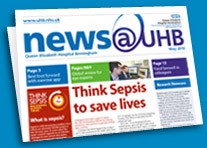Your views

Your feedback is vital to us as we continue to increase the quality of our services.
You are here:
Date: 27 January 2025
Time: 16:57
Drug alerts system supports patient safety
Story posted/last updated: 01 August 2013
Researchers from Queen Elizabeth Hospital Birmingham (QEHB) and University of Birmingham (UoB) have shown that a specialised drug prescribing system could help prevent a repetition of the notorious 2002 killings of elderly patients by nurse Colin Norris.
A nurse at the Leeds General Infirmary and St James Hospitals, Norris was convicted in 2008 of murdering four patients using insulin, which lowered their blood glucose levels and led to their deaths. The condition of a low blood glucose concentration is known as hypoglycaemia.
One question raised by the case was how likely it is for so many patients to suffer from hypoglycaemia, a condition that is rare in patients if they are not being treated for diabetes or in critical care.
Researchers at QEHB and UoB have now analysed information on 37,898 inpatients to establish how commonly hypoglycaemia occurs among non-diabetic patients on general wards.
The study was funded by the National Institute for Health Research (NIHR) via the Collaborations for Leadership in Applied Health Research and Care (CLAHRC) for Birmingham and the Black Country.
They confirmed that significant hypoglycaemia is rare in non-diabetic patients, but also identified the potential for the hospital’s clinical decision support system to spot unexplained clusters of the condition.
This could enable clinicians to spot the sort of misuse of insulin which led to the deaths of patients under the care of Colin Norris and other convicted killers.
In 1991 nurse Beverley Allitt was found guilty of murdering four children and trying to kill another nine at a hospital in Lincolnshire. In 2006 staff nurse Benjamin Geen was convicted of murdering two of his patients and attacking fifteen others with injections including insulin at a hospital in Oxfordshire.
Dr Krishnarajah Nirantharakumar, a clinical research fellow at UoB, led the research, which used University Hospitals Birmingham NHS Foundation Trust's (UHB) in-house developed Prescribing, Information and Communication System (PICS) to look at hypoglycaemia patients.
“We looked back at the rate of hypoglycaemia in non-diabetic patients outside critical care for 2010, and we found that it was very rare: only 13 in every 10,000 admissions below a blood glucose value of 2.7mmol/l. We then analysed the case notes of the patients whose blood glucose concentration was below this value and found most had plausible medical explanations in the case notes,” says Dr Niranthakumar.
“Then, because it was shown to be so rare, we questioned whether we could identify these patients using PICS while they’re with us. If so, then it would be a way of increasing vigilance for the misuse of insulin like in the Colin Norris case.”
Dr Jamie Coleman, a consultant clinical pharmacologist at QEHB, says the potential for increasing patient safety is a further benefit of an already successful system.
Dr Coleman said: “We have very good information systems that can provide retrospective surveillance data like this, but these systems also provide secondary benefits with automatic collection of data which may allow a greater degree of surveillance for patient safety.
“Within our organisation there were, ultimately, no unexplained cases but the potential is there to improve safety further.”
The research, “Hypoglycaemia in Non-Diabetic In-Patients: Clinical or Criminal?” is available on the PLoS ONE website.
University Hospitals Birmingham NHS Foundation Trust is not responsible for the contents or the reliability of external websites and does not necessarily endorse the views expressed within them. Listing should not be taken as endorsement of any kind. We cannot guarantee that links to other websites will work all of the time, and we have no control over the availability of external web pages.

Getting here
Information about travelling to, staying at and getting around the hospital.

Jobs at UHB
A great place to work. Learn why.
news@UHB


RSS feed
Subscribe to our news feed


